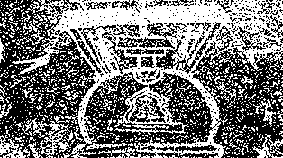Lokapalas and caturmaharajikas in rock carvings
at Chilas and Thalpan on the Upper Indus (Pakistan).
Wiesenbach 1999(Deutsche Fassung)


Three stupa-representations in Chilas-I and in Thalpan-I show figures standing on top of the anda. Possibly two more such figures are depicted on top of another stupa, but this is not for certain because of the very sketchy drawing – see figs. 3 and 4.
All three certain occurrences are donated by Kuberavahana. The figures represent the "guardians of the world" (dikpalas, caturmaharajikas). [fn 1]
While the caturmaharajikas on top of the stupa in Chilas-I as well as those on stone 208 at Thalpan-I hold spears in their hands and thus proudly show their being "guardians of the world" [fn 2], the figures on top of stupa 277:144 at Thalpan-I could be better compared with buddhas or bodhisattvas. They do not wear the long ('Kusana')-coat[fn 3] which is usually typical for the lokapalas in the North-West; a nimbus is visible behind their heads, and as a matter of fact they do not hold spears, but rise their right hands more in a kind of abhaya-mudra. This carving, donated by Kuberavahana, is not only different in the way the figures are represented, it also shows shows three figures – instead of two, as the others do – and they are shown in front of a uniformly hammered plate, resembling a wall panel.
Figures:[1] ^ Regarding the symbolic meaning of the caturmaharajikas see Tucci 1932: 80 ff.; Gail 1980: 262 "The Buddhist cosmography ... knows four great kings (caturmaharajika) whose abodes are the four sides of Meru, and who also serve as protectors of the world." und Anm. 29: Kirfel, Die Kosmographie der Inder, pp. 35, 191, 195 sq.; ibid. S. 263, Anm. 32: Michell , George, 1973. The Regents of the Directions of Space: A Set of Sculptural Panels from Alampur. In: AARP 4: 80-86. Following Gail this is one of the earliest examples for figures like the astadikpalas, which presumably have evolved out of the caturmaharajikas. Cf. Franz 1978c: Fig. 43, bronze-stupa in the Peshawar Museum. Two more votiv-stupas with caturmaharajikas in Faccenna 1986a: Abb. 28-30 – the guardians of the world on top of the stupa in Peshawar obviously hold spears and swords in their hands ; cf. stupas of the 5./6. centuries CE in caves of Western India, for example Ajanta XIX und XXVI: Fischer 1959: Fig. 131; Fussman 1986: 47 "In Nepal, eyes are painted on the harmika – and are said to represent the four loka-palas. In Sri Lanka, over the harmika – a cylindrical devata-kotuwa, 'house of gods', is built, on which are sometimes carved the eight asta-dik-palas."
[2] ^ Like, for example, the female guardians in a relief from Gandhara showing "Queen Maya's dream", who are depicted in the same pose: Foucher 1905: Fig. 149 – obviously a very old iconographic motif, cf. the Yaksa-representation from Sanci: Foucher 1918: Fig. 470.
[3] ^ Cf. the representation of a person in 'Kusana'-dress from Hunza-Haldeikish.
The cited works can be found in the bibliography to "Stupas, Tempel und verwandte Bauwerke..." (which is in German for the time being : a translation is in preparation—but that will take even some more time).
My special thanks for her kind help with the english version to Angie Dröber from ueber:satz.de.